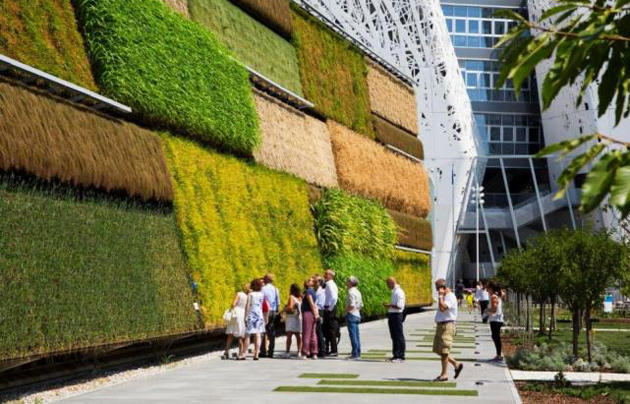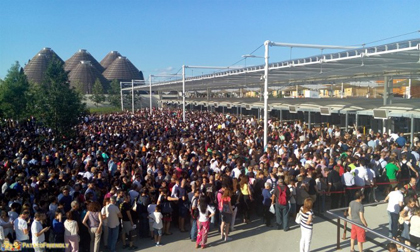Expo Milano: food, sustainability and spirituality
It is like a huge theme park centred on the theme of feeding the world. Expo Milano has been viewed by over 14 million visitors who have gone through the gates and into the Rho area in the first four months.
MILANO · 15 SEPTEMBER 2015 · 14:17 CET

The Expo Milano is now two-thirds of the way through its duration.
Since the beginning of May, 14 million people have visited the Rho area with its fifty-three national stands and the nine areas with the theme: “Feeding the planet, energy for life”. The invitation is to support food sustainability and to seek spirituality.
THE IMPACT
Crossing the Decumano, the central walkway where most of the stands have been set up, one is struck by the scenery; the carnival-like colours, shapes and sounds which the main stands all have in common are more like a visual surprise than an invitation to make any discoveries.
Perhaps there has been too much emphasis on trying to get people involved rather than just looking at safe, sustainable and sufficient food. Inevitably, enthusiastic children drag their families towards the interactive areas whilst it is a lot quieter around the more ‘thinking’ themed stands.

In actual fact, the results show that the organizers were right. Two-thirds of the way through, everything is going as planned and the number of visitors has stayed unexpectedly high even after the August Bank holiday (August 15th) with 3,300,000 during the last month. This meant getting operators back from their summer holidays to deal with the unexpected numbers. With such winning results there is no room for criticism and, after all, it is not easy to create a huge project with such an enormous impact on the public and so much to offer.
However in the Decumano tourbillon, any visitor wanting to go beyond just appearances can always find reason for reflection and even, maybe, discover something useful regarding the rather refined subject of food.
THE SPIRITUAL APPROACH
Worth noting are the constant queues of visitors outside the Israeli pavilion. People in line, patiently waiting, at all hours of the day, to be part of the experience inspired by the theme “Israel, the fields of tomorrow” which is solidly anchored in the past, the Biblical past too. It is about a country that has, patiently and innovatively, been able to make the arid deserts flourish.
Fewer visitors, in spite of its central position, instead, to the Holy See stand. There is a more spiritual theme here and no surprise effects, pauses between spectacular experiences are almost meditative. Inside the stand there are three themes: on one side, multimedia images which portray world dramas from hunger to violence and on the other side humanitarian efforts set up to help the needy. In the middle of the two, sharing yet uniting them, a long screen with a Rubens tapestry from the 16th century in typical Flemish style depicting the Last Supper. It is from the diocese of Ancona and substitutes a Tintoretto painting which was exhibited for the first half of the Expo. The guide explains to those patiently listening that the work of art is a celebration in which the details are of great significance. The eleven disciples are looking at Jesus who is blessing the bread and wine whilst one of them, Judas, is turning away, uninterested. The visitor is challenged to ask himself whether, faced with the evils of this world, he can look to Christ and be moved to make his own contribution or look the other way as the betraying disciple did.
THE THEME
Apart from the opportune spiritual references and various themed meeting underlining the link between food and spirituality that have been organized by Expo during the six month it is opened, it’s also important to remember the numerous Bible references to food. These are at a practical level as well as being spiritual metaphors and it is the Exhibition itself that synthetically offers reasons for reflection which will, hopefully, be remembered in the long term.

Two very different stands which are both attractive but at the same time very effective in getting their message across need to be mentioned.
The most noteworthy is the Swiss stand. It is made up of four glass and steel towers which are filled with all kinds of local food. The visitor is invited to help himself to the food but with the warning that the food resources have to last for the full six months of Expo and are therefore limited, just as the Earth’s resources are limited. Thus, if the first-comers are selfish and take more than their due, those who come later will have less. It’s a good way of teaching and is made even better by the visual impact – the emptying effect can be seen through the glass of the towers. Consumers are invited to be responsible and to share.
Another significant example is from the United Kingdom. It concentrates on the fundamental role of bees in the ecosystem. The visitor goes across a trench-like lawn which provides the kind of vision that a bee would have. At the end there is a complex steel structure which looks like a hive. Thanks to modern technology, led lights are connected through sensors to a real hive in England so it is possible to understand how and when the bees come and go as the hours go by. The effect as night falls is particularly evocative. “If bees become extinct” the guide cautions “humanity would not live for many more years so it is particularly important to take care of them”
CREATION
That’s right. Caring for creation. This is a subject often underestimated by Christians who concentrate on other things – often not as spiritual as they would have people believe – and tend to be uncaring of the specific divine commandment. Over the years we have not understood this commandment which is an invitation that involves good sense but a necessary indication to our own survival.
We don’t have to necessarily get involved in environmental campaigns or marches for ecology in order to look after creation. Just as ‘feeding the planet’ outside of emergency situations does not need massive action.
Maintaining creation, just like maintaining our spiritual health, doesn’t need showy measures and neither does feeding the needy from a practical and spiritual point of view. Results depend on everyday acts, ethical choices and a sense of responsibility on behalf of each one of us.
Expo 2015, with its kaleidoscope of colours and entertainment can help us remember this and maybe it can even convince us to get back on track and take up again the social and moral stand that the world expects from Christians.
Published in: Evangelical Focus - cities - Expo Milano: food, sustainability and spirituality
